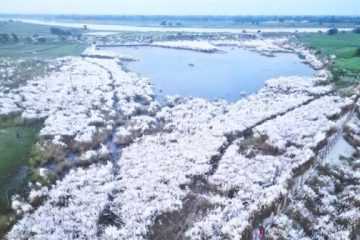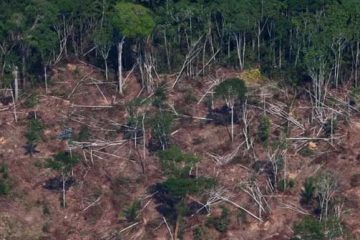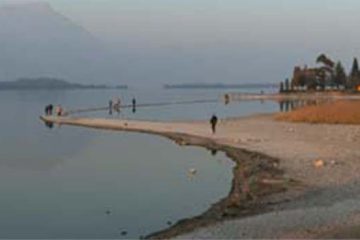Dr. Md. Mizanur Rahman
 The word “riparian” is derived from the Latin word ‘Ripa’ (river bank).Vegetations bordering water bodies are technically known as riparian vegetations.
The word “riparian” is derived from the Latin word ‘Ripa’ (river bank).Vegetations bordering water bodies are technically known as riparian vegetations.
These vegetations are also called riverine or gallery vegetations as they are grown adjacent to or near rivers. Plant habitats and communities along the river margins and banks are called riparian vegetation, characterized by hydrophilic plants. Riparian vegetations form the transition between the aquatic and the terrestrial ecosystem. A riparian zone or riparian area is the interface between land and water body. Riparian is also the proper nomenclature for one of the fifteen terrestrial biomes of the earth. They occur in many forms including grassland, woodland, wetland or even non-vegetative.
Role in ecology: Tropical and sub-tropical riparian vegetations are characterized as being extremely dense and productive, and have large numbers of climbing plants. They are important in preserving water quality and controlling erosion. They provide habitat for wildlife refuges especially for amphibians and reptiles. Birds, monkeys and tree dwelling mammals are highly abundant in these forests. Riparian vegetations are the habitats of many fish species. They supply shelter and food for many aquatic animals and shade that is an important part of stream temperature regulation. The riparian zones increase biodiversity, and provide wildlife corridors enabling aquatic and riparian organisms to move along river systems avoiding isolated communities. They provide forage for wildlife and livestock.
Role as a bio-filter: Riparian zones play significant roles in ecology and environmental management because of their role in soil conservation and the influences they have on fauna and aquatic ecosystems. They are vegetative buffer which prevent sediment reaching water bodies and trap agricultural chemicals from overland water flow contributing to downstream water quality. They maintain stable water temperatures and prevent sedimentation both of which are important for maintaining fish populations. Riparian forests decrease soil salinity. Deforestation leads to a rise in the water table level. Capillary action draws water to the surface and salts are concentrated by surface evaporation. Seepage of water also causes down-slope salinity. Riparian zones play a role in lowering nitrate contamination in surface runoff from agricultural fields.
Role in preventing soil erosion: Riparian vegetations stabilize stream banks by providing deep root systems which hold the soil in place and by providing a degree of roughness capable of slowing runoff velocities and spreading flow during storm surges. They prevent erosion of stream banks and the production of sediments. Without forest buffers, stream flow scours the streambed and banks leading to bank erosion and channel straightening. The straight channels lead to accelerated stream flow velocity and additional stream bank erosion.
Role as a shelterbelt: One of the most important roles of riparian forests on their immediate environment is to reduce wind speeds. Many parts of the world use these forests as windbreaks or shelterbelts — to protect crops, water sources, soils and settlements. They are essential for dune stabilization as well. Windbreaks reduce wind speeds; prevent wind erosion and the damages it causes. The damages include the loss of nutrient-rich topsoil and physical injury to crops and livestock. Riparian forests have a considerable influence in reducing wind velocity at the soil surface.
The biodiversity of riparian vegetation in Bangladesh: The vegetations of the banks of Naf, Kornofuli, Pusur, Bishkhali, Payra, Agunmukha, East-Baleswar (or Haringhata), Raimangal and Hariabhanga rivers, and Hatia Channel can be considered as the riparian vegetations.
The floral diversity of riparian vegetation is characterised by Keora, Gewa, Kakra, Khalsi, Hargoza, Bain, Golpata, Hanthol, Pandanus (Screw pine) and Hogla (a robust herb). They are home to Corals, Crabs, Snails, Oysters, Mollusks, Brittle Star, Algae, Nudibranch, Bryozoans, Tortoises, Snakes and Weeds. They provide excellent nurseries for Shrimps, Hilsha Fish, Zebra Fish, Hamilton Fish, Asian Sea Bass, Black Sea Bass, Silver Pomfret and Dolphins. They are very important habitats for Monkeys, Wild Boar, Wild Buffaloes, Fishing Cat, River Terrapin, Bengal Monitor, Black Lizard, Yellow Monitor, Swamp Partridge, Trogon, Ground Thrush, Water Monitor, Macaques, Forest Wagtail, Green Frog, Grey Mongoose, Scarlet Minivet, Ring Lizard, Pangolin, Drongo, Oriental Small-Clawed Otter, Chital and other threatened species. Riparian vegetation is the paradise for Black-Crowned Night-Heron, Pond Heron, Grey Heron, Purple Heron, Cattle Egret, Little Egret, Lesser Whistling-Duck, Bar-Headed Goose, Cotton Pygmy-Goose, Common Shelduck, Ruddy Shelduck, Tufted Duck, Water Cock , Ring-Billed Gull, Herring Gull, Noisy Gull, Hawks, Swallows, Falcons, Small Cranes, White-Winged Duck, Sarus Crane, Eurasian Thick-Knee, Indian Cormorant, White-Bellied Heron, Pacific Reef Egret, , Pigmy Woodpecker, Brown Wing Kingfisher, Malayan Night Heron, Glossy Ibis, Woolly-Necked Stork, Asian Openbill, Indian Pond Heron, Black-Bellied Tern, Gull-Billed Tern, Spot-Billed Duck, etc.
Conservation
o Declaring riparian vegetation as the refuge ecosystem for plant and wildlife
o Prohibiting clearance of wood and shrubs within 25 m on both sides of any waterway
o Rare species will not be cut either inside or outside of the gallery vegetation
o Preserving not only the river front, interior and riparian forest edge but also parts of the adjacent upland forest
o Promoting local people in conservation programme
o Aforestation in the open sand dunes by the plant species which have ‘prop roots’ to anchor itself in the loose sand
o Monitoring of biological resources of riparian vegetations
o Establishing an information system of riparian biodiversity
o Emphasizing on ex-situ conservation of endangered species
o Creating public awareness by using different media
o Raising funds for conservation programme
o Maintaining and restoring mangroves
o Maintaining at least two canopy layers (bimodal or reverse J-shaped diameter distribution)
o Maintaining at least two main canopy tree species suited to the sites
o Passive management to develop tree size canopy structure and decadence
o Planting large diameter trees with strong root systems to provide critical structure for fish habitat and to prevent chronic erosion of stream banks
o Strengthening forest monitoring, research and development, education, and capacity building to maintain a “cradle” of biodiversity in the riparian buffer zone
o Halting the continued introduction of alien invasive species
o Gap filling by rare tree species
o Facilitating natural regeneration in degraded areas
o Protecting natural regenerations (seedling, sapling and juvenile trees) from cutting
o Establishing gene banks to conserve the gene pool of endangered species
o Bringing endangered animals in captivity for breeding
Image (above) Caption: L-R: Protecting riverbank slopes and guarding against erosion.
Dr. Md. Mizanur Rahman, a biodiversity specialist, is Assistant Commissioner, Jhalakathi Collectorate (mizan_peroj @yahoo.com)





